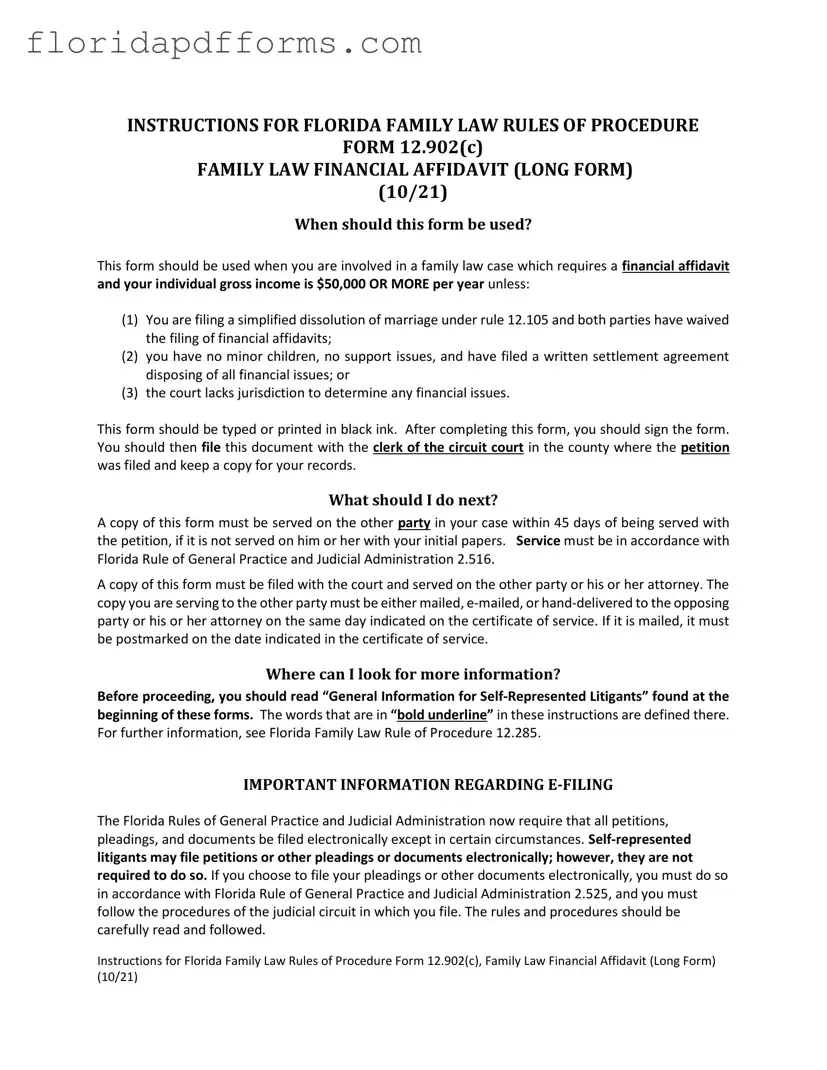INSTRUCTIONS FOR FLORIDA FAMILY LAW RULES OF PROCEDURE
FORM 12.902(c)
FAMILY LAW FINANCIAL AFFIDAVIT (LONG FORM)
(10/21)
When should this form be used?
This form should be used when you are involved in a family law case which requires a financial affidavit and your individual gross income is $50,000 OR MORE per year unless:
(1)You are filing a simplified dissolution of marriage under rule 12.105 and both parties have waived the filing of financial affidavits;
(2)you have no minor children, no support issues, and have filed a written settlement agreement disposing of all financial issues; or
(3)the court lacks jurisdiction to determine any financial issues.
This form should be typed or printed in black ink. After completing this form, you should sign the form. You should then file this document with the clerk of the circuit court in the county where the petition was filed and keep a copy for your records.
What should I do next?
A copy of this form must be served on the other party in your case within 45 days of being served with the petition, if it is not served on him or her with your initial papers. Service must be in accordance with Florida Rule of General Practice and Judicial Administration 2.516.
A copy of this form must be filed with the court and served on the other party or his or her attorney. The copy you are serving to the other party must be either mailed, e-mailed, or hand-delivered to the opposing party or his or her attorney on the same day indicated on the certificate of service. If it is mailed, it must be postmarked on the date indicated in the certificate of service.
Where can I look for more information?
Before proceeding, you should read “General Information for Self-Represented Litigants” found at the beginning of these forms. The words that are in “bold underline” in these instructions are defined there. For further information, see Florida Family Law Rule of Procedure 12.285.
IMPORTANT INFORMATION REGARDING E-FILING
The Florida Rules of General Practice and Judicial Administration now require that all petitions, pleadings, and documents be filed electronically except in certain circumstances. Self-represented litigants may file petitions or other pleadings or documents electronically; however, they are not required to do so. If you choose to file your pleadings or other documents electronically, you must do so in accordance with Florida Rule of General Practice and Judicial Administration 2.525, and you must follow the procedures of the judicial circuit in which you file. The rules and procedures should be carefully read and followed.
Instructions for Florida Family Law Rules of Procedure Form 12.902(c), Family Law Financial Affidavit (Long Form) (10/21)
IMPORTANT INFORMATION REGARDING E-SERVICE ELECTION
After the initial service of process of the petition or supplemental petition by the Sheriff or certified process server, the Florida Rules of General Practice and Judicial Administration now require that all documents required or permitted to be served on the other party must be served by electronic mail (e- mail) except in certain circumstances. You must strictly comply with the format requirements set forth in the Florida Rules of General Practice and Judicial Administration. If you elect to participate in electronic service, which means serving or receiving pleadings by electronic mail (e-mail), or through the Florida Courts E-Filing Portal, you must review Florida Rule of General Practice and Judicial Administration 2.516. You may find this rule at www.flcourts.org through the link to the Rules of General Practice and Judicial Administration provided under either Family Law Forms: Getting Started, or Rules of Court in the A-Z Topical Index.
SELF-REPRESENTED LITIGANTS MAY SERVE DOCUMENTS BY E-MAIL; HOWEVER, THEY ARE NOT REQUIRED TO DO SO. If a self-represented litigant elects to serve and receive documents by email, the procedures must always be followed once the initial election is made.
To serve and receive documents by e-mail, you must designate your e-mail addresses by using the Designation of Current Mailing and E-mail Address, Florida Supreme Court Approved Family Law Form 12.915, and you must provide your e-mail address on each form on which your signature appears. Please CAREFULLY read the rules and instructions for: Certificate of Service (General), Florida Supreme Court Approved Family Law Form 12.914; Designation of Current Mailing and E-mail Address, Florida Supreme Court Approved Family Law Form 12.915; and Florida Rule of General Practice and Judicial Administration 2.516.
Special notes . . .
If you want to keep your address confidential because you have been found by a judge to be the victim of sexual battery, aggravated child abuse, aggravated stalking, harassment, aggravated battery, or domestic violence do not enter the address, telephone, and fax information at the bottom of this form. Instead, file Request for Confidential Filing of Address, Florida Supreme Court Approved Family Law Form 12.980(h).
The affidavit must be completed using monthly income and expense amounts. If you are paid or your bills are due on a schedule which is not monthly, you must convert those amounts. Hints are provided below for making these conversions.
Instructions for Florida Family Law Rules of Procedure Form 12.902(c), Family Law Financial Affidavit (Long Form) (10/21)
Hourly - If you are paid by the hour, you may convert your income to monthly as follows:
Hourly amount |
x |
Hours worked per week |
= |
Weekly amount |
Weekly amount |
x |
52 Weeks per year |
= |
Yearly amount |
Yearly amount |
÷ |
12 Months per year |
= |
Monthly Amount |
Daily - If you are paid by the day, you may convert your income to monthly as follows: |
Daily amount |
x |
Days worked per week |
= |
Weekly amount |
Weekly amount |
x |
52 Weeks per year |
= |
Yearly amount |
Yearly amount |
÷ |
12 Months per year |
= |
Monthly Amount |
Weekly - If you are paid by the week, you may convert your income to monthly as follows:
Weekly amount |
x |
52 Weeks per year |
= |
Yearly amount |
Yearly amount |
÷ |
12 Months per year |
= |
Monthly Amount |
Bi-weekly - If you are paid every two weeks, you may convert your income to monthly as follows:
Bi-weekly amount |
x |
26 |
= |
Yearly amount |
Yearly amount |
÷ |
12 Months per year |
= |
Monthly Amount |
Semi-monthly - If you are paid twice per month, you may convert your income to monthly as
follows: |
|
|
|
Semi-monthly amount x |
2 |
= |
Monthly Amount |
Expenses may be converted in the same manner.
Remember, a person who is NOT an attorney is called a nonlawyer. If a nonlawyer helps you fill out these forms, that person must give you a copy of a Disclosure from Nonlawyer, Florida Family Law Rules of Procedure Form 12.900(a), before he or she helps you. A nonlawyer helping you fill out these forms also must put his or her name, address, and telephone number on the bottom of the last page of every form he or she helps you complete.
Instructions for Florida Family Law Rules of Procedure Form 12.902(c), Family Law Financial Affidavit (Long Form) (10/21)
IN THE CIRCUIT COURT OF THE |
JUDICIAL CIRCUIT, |
IN AND FOR |
COUNTY, FLORIDA |
Case No.:
Division:
,
Petitioner,
and
,
Respondent.
FAMILY LAW FINANCIAL AFFIDAVIT (LONG FORM)
($50,000 or more Individual Gross Annual Income)
I, {full legal name} |
, being sworn, certify |
that the following information is true: |
|
SECTION I. INCOME
1.My age is:
2.My occupation is:
3.I am currently
[Check all that apply]
a.Unemployed
Describe your efforts to find employment, how soon you expect to be employed, and the pay you expect to receive:
b.Employed by:
Address: |
|
|
City, State, Zip code: |
Telephone Number: |
Pay rate: $ |
( ) every week ( |
) every other week ( ) twice a month |
( ) monthly ( |
) other: |
|
If you are expecting to become unemployed or change jobs soon, describe the change you expect and why and how it will affect your income:
.
_______Check here if you currently have more than one job. List the information above for the
second job(s) on a separate sheet and attach it to this affidavit.
Florida Family Law Rules of Procedure Form 12.902(c), Family Law Financial Affidavit (Long Form) (10/21)
c._ Retired. Date of retirement: Employer from whom retired: Address:
City, State, Zip code: |
|
Telephone Number: |
LAST YEAR’S GROSS INCOME: |
Your Income |
Other Party’s Income (if known) |
YEAR _____ |
$ _______ |
$ _______ |
PRESENT MONTHLY GROSS INCOME:
All amounts must be MONTHLY. See the instructions with this form to figure out money amounts for anything that is NOT paid monthly. Attach more paper, if needed. Items included under “other” should be listed separately with separate dollar amounts.
1.$______ Monthly gross salary or wages
2._______ Monthly bonuses, commissions, allowances, overtime, tips, and similar payments
3._______ Monthly business income from sources such as self-employment, partnerships, close corporations, and/or independent contracts (Gross receipts minus ordinary and necessary expenses required to produce income.)(Attach sheet itemizing such income and expenses.)
4._______ Monthly disability benefits/SSI
5._______ Monthly Workers’ Compensation
6._______ Monthly Unemployment Compensation
7._______ Monthly pension, retirement, or annuity payments
8._______ Monthly Social Security benefits
9._______ Monthly alimony actually received (Add 9a and 9b)
9a. From this case: $________
9b. From other case(s): $________
10._______ Monthly interest and dividends
11._______ Monthly rental income (gross receipts minus ordinary and necessary expenses required to produce income) (Attach sheet itemizing such income and expense items.)
12._______ Monthly income from royalties, trusts, or estates
13._______ Monthly reimbursed expenses and in-kind payments to the extent that they reduce personal living expenses (Attach sheet itemizing each item and amount.)
14._______ Monthly gains derived from dealing in property (not including nonrecurring gains)
_______ Any other income of a recurring nature (identify source):
15._______________________________________________________________________________
16._______________________________________________________________________________
17.$_________ TOTAL PRESENT MONTHLY GROSS INCOME (Add lines 1 through 16.)
PRESENT MONTHLY DEDUCTIONS:
All amounts must be MONTHLY. See the instructions with this form to figure out money amounts for anything that is NOT paid monthly.
18.$_______ Monthly federal, state, and local income tax (corrected for filing status and allowable dependents and income tax liabilities)
a.Filing Status
b.Number of dependents claimed
19. _______ Monthly FICA or self-employment taxes
Florida Family Law Rules of Procedure Form 12.902(c), Family Law Financial Affidavit (Long Form) (10/21)
20._______ Monthly Medicare payments
21._______ Monthly mandatory union dues
22._______ Monthly mandatory retirement payments
23._______ Monthly health insurance payments (including dental insurance), excluding portion paid for any minor children of this relationship
24._______ Monthly court-ordered child support actually paid for children from another relationship
25._______ Monthly court-ordered alimony actually paid (Add 25a and 25b)
25a. from this case: $ _________
25b. from other case(s): $ _________
26.$______ TOTAL DEDUCTIONS ALLOWABLE UNDER SECTION 61.30, FLORIDA STATUTES (Add lines 18 through 25.)
27.$______ PRESENT NET MONTHLY INCOME
(Subtract line 26 from line 17.)
SECTION II. AVERAGE MONTHLY EXPENSES
Proposed/Estimated Expenses. If this is a dissolution of marriage case and your expenses as listed below do not reflect what you actually pay currently, you should write “estimate” next to each amount that is estimated.
HOUSEHOLD:
1.$______ Monthly mortgage or rent payments
2._______ Monthly property taxes (if not included in mortgage)
3._______ Monthly insurance on residence (if not included in mortgage)
4._______ Monthly condominium maintenance fees and homeowner’s association fees
5._______ Monthly electricity
6._______ Monthly water, garbage, and sewer
7._______ Monthly telephone
8._______ Monthly fuel oil or natural gas
9._______ Monthly repairs and maintenance
10._______ Monthly lawn care
11._______ Monthly pool maintenance
12._______ Monthly pest control
13._______ Monthly misc. household
14._______ Monthly food and home supplies
15._______ Monthly meals outside home
16._______ Monthly cable t.v.
17._______ Monthly alarm service contract
18._______ Monthly service contracts on appliances
19._______ Monthly maid service
Other:
20.__________________________________________________________________________________
21.__________________________________________________________________________________
22.__________________________________________________________________________________
23.__________________________________________________________________________________
24.__________________________________________________________________________________
25.$__________ SUBTOTAL (Add lines 1 through 24.)
Florida Family Law Rules of Procedure Form 12.902(c), Family Law Financial Affidavit (Long Form) (10/21)
AUTOMOBILE:
26.$______ Monthly gasoline and oil
27._______ Monthly repairs
28._______ Monthly auto tags and emission testing
29._______ Monthly insurance
30._______ Monthly payments (lease or financing)
31._______ Monthly rental/replacements
32._______ Monthly alternative transportation (bus, rail, car pool, etc.)
33._______ Monthly tolls and parking
34._______ Other: _________________________________________________
35.$_______ SUBTOTAL (Add lines 26 through 34.)
MONTHLY EXPENSES FOR CHILDREN COMMON TO BOTH PARTIES:
36.$______ Monthly nursery, babysitting, or day care
37._______ Monthly school tuition
38._______ Monthly school supplies, books, and fees
39._______ Monthly after school activities
40._______ Monthly lunch money
41._______ Monthly private lessons or tutoring
42._______ Monthly allowances
43._______ Monthly clothing and uniforms
44._______ Monthly entertainment (movies, parties, etc.)
45._______ Monthly health insurance
46._______ Monthly medical, dental, prescriptions (nonreimbursed only)
47._______ Monthly psychiatric/psychological/counselor
48._______ Monthly orthodontic
49._______ Monthly vitamins
50._______ Monthly beauty parlor/barber shop
51._______ Monthly nonprescription medication
52._______ Monthly cosmetics, toiletries, and sundries
53._______ Monthly gifts from child(ren) to others (other children, relatives, teachers, etc.)
54._______ Monthly camp or summer activities
55._______ Monthly clubs (Boy/Girl Scouts, etc.)
56._______ Monthly time-sharing expenses
57._______ Monthly miscellaneous
58.$_______ SUBTOTAL (Add lines 36 through 57.)
MONTHLY EXPENSES FOR CHILD(REN) FROM ANOTHER RELATIONSHIP (other than court-ordered child support)
59.$________________________________________________________________________________
60.__________________________________________________________________________________
61.__________________________________________________________________________________
62.__________________________________________________________________________________
63.$_______ SUBTOTAL (Add lines 59 through 62.)
Florida Family Law Rules of Procedure Form 12.902(c), Family Law Financial Affidavit (Long Form) (10/21)
MONTHLY INSURANCE:
64.$______ Health insurance (if not listed on lines 23 or 45)
65._______ Life insurance
66._______ Dental insurance.
Other:
67.________________________________________________________________________________
68.________________________________________________________________________________
69. $_______ SUBTOTAL (Add lines 66 through 68, exclude lines 64 and 65.)
OTHER MONTHLY EXPENSES NOT LISTED ABOVE:
70.$______ Monthly dry cleaning and laundry
71._______Monthly clothing
72._______ Monthly medical, dental, and prescription (unreimbursed only)
73._______ Monthly psychiatric, psychological, or counselor (unreimbursed only)
74._______ Monthly non-prescription medications, cosmetics, toiletries, and sundries
75._______ Monthly grooming
76._______ Monthly gifts
77._______ Monthly pet expenses
78._______ Monthly club dues and membership
79._______ Monthly sports and hobbies
80._______ Monthly entertainment
81._______ Monthly periodicals/books/tapes/CDs
82._______ Monthly vacations
83._______ Monthly religious organizations
84._______ Monthly bank charges/credit card fees
85._______ Monthly education expenses
86._______ Other: (include any usual and customary expenses not otherwise mentioned in the items
listed above)________________________________________________________________
87.__________________________________________________________________________________
88.__________________________________________________________________________________
89.__________________________________________________________________________________
90. $_______ SUBTOTAL (Add lines 70 through 89.)
MONTHLY PAYMENTS TO CREDITORS: (only when payments are currently made by you on outstanding balances). List only last 4 digits of account numbers.
MONTHLY PAYMENT AND NAME OF CREDITOR(s):
91.$_________________________________________________________________________________
92.__________________________________________________________________________________
93.__________________________________________________________________________________
94.__________________________________________________________________________________
95.__________________________________________________________________________________
96.__________________________________________________________________________________
97.__________________________________________________________________________________
98.__________________________________________________________________________________
99.__________________________________________________________________________________
100._________________________________________________________________________________
101._________________________________________________________________________________
Florida Family Law Rules of Procedure Form 12.902(c), Family Law Financial Affidavit (Long Form) (10/21)
102._________________________________________________________________________________
103.______________________________________________________________________________
104. $_______ SUBTOTAL (Add lines 91 through 103.)
105. $_______ TOTAL MONTHLY EXPENSES:
(Add lines 25, 35, 58, 63, 69, 90, and 104 of Section II, Expenses.)
SUMMARY
106. $_______ TOTAL PRESENT MONTHLY NET INCOME (from line 27 of SECTION I. INCOME)
107. $_______ TOTAL MONTHLY EXPENSES (from line 105 above)
108. $_______ SURPLUS (If line 106 is more than line 107, subtract line 107 from line 106. This is the
amount of your surplus. Enter that amount here.)
109. ($______) (DEFICIT) (If line 107 is more than line 106, subtract line 106 from line 107. This is
the amount of your deficit. Enter that amount here.)
SECTION III. ASSETS AND LIABILITIES
A.ASSETS (This is where you list what you OWN.)
INSTRUCTIONS:
STEP 1: In column A, list a description of each separate item owned by you (and/or your spouse, if this is a petition for dissolution of marriage). Blank spaces are provided if you need to list more than one of an item.
STEP 2: If this is a petition for dissolution of marriage, check the line in Column A next to any item that you are requesting the judge award to you.
STEP 3: In column B, write what you believe to be the current fair market value of all items listed.
STEP 4: Use column C only if this is a petition for dissolution of marriage and you believe an item is “nonmarital,” meaning it belongs to only one of you and should not be divided. You should indicate to whom you believe the item belongs. (Typically, you will only use Column C if property was owned by one spouse before the marriage. See the “General Information for Self-Represented Litigants” found at the beginning of these forms and section 61.075(1), Florida Statutes, for definitions of “marital” and “nonmarital” assets and liabilities.)
Florida Family Law Rules of Procedure Form 12.902(c), Family Law Financial Affidavit (Long Form) (10/21)
A
ASSETS: DESCRIPTION OF ITEM(S)
LIST ONLY LAST FOUR DIGITS OF ACCOUNT NUMBERS. Check the line next to any asset(s) which you are requesting the judge award to you.
 Cash (on hand)
Cash (on hand)
 Cash (in banks or credit unions)
Cash (in banks or credit unions)
 Stocks/Bonds
Stocks/Bonds
 Notes (money owed to you in writing)
Notes (money owed to you in writing)
 Money owed to you (not evidenced by a note)
Money owed to you (not evidenced by a note)
 Real estate: (Home)
Real estate: (Home)  (Other)
(Other)
 Business interests
Business interests
 Automobiles
Automobiles
 Boats
Boats
B |
C |
|
Current |
Nonmarital |
|
Fair |
(Check correct column) |
Market |
|
|
Value |
|
|
|
Petitioner |
Respondent |
$ |
|
|
Florida Family Law Rules of Procedure Form 12.902(c), Family Law Financial Affidavit (Long Form) (10/21)






 Cash (on hand)
Cash (on hand) Cash (in banks or credit unions)
Cash (in banks or credit unions) Stocks/Bonds
Stocks/Bonds Notes (money owed to you in writing)
Notes (money owed to you in writing) Money owed to you (not evidenced by a note)
Money owed to you (not evidenced by a note) Real estate: (Home)
Real estate: (Home)  (Other)
(Other) Business interests
Business interests Automobiles
Automobiles Boats
Boats